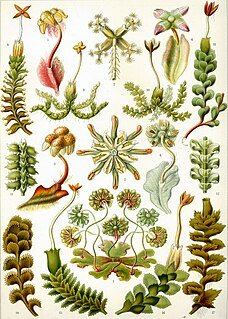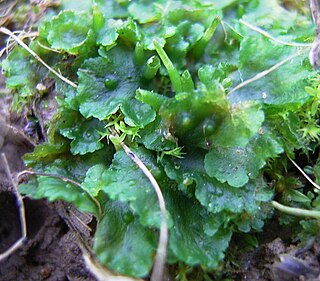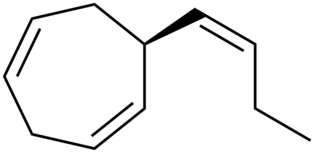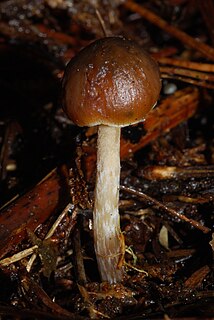
Bryophytes are an informal group consisting of three divisions of non-vascular land plants (embryophytes): the liverworts, hornworts and mosses. They are characteristically limited in size and prefer moist habitats although they can survive in drier environments. The bryophytes consist of about 20,000 plant species. Bryophytes produce enclosed reproductive structures, but they do not produce flowers or seeds. They reproduce via spores. Bryophytes are usually considered to be a paraphyletic group and not a monophyletic group, although some studies have produced contrary results. Regardless of their status, the name is convenient and remains in use as an informal collective term. The term "bryophyte" comes from Greek βρύον, bryon "tree-moss, oyster-green" and φυτόν, phyton "plant".

The Marchantiophyta are a division of non-vascular land plants commonly referred to as hepatics or liverworts. Like mosses and hornworts, they have a gametophyte-dominant life cycle, in which cells of the plant carry only a single set of genetic information.

Hornworts are a group of bryophytes constituting the division Anthocerotophyta. The common name refers to the elongated horn-like structure, which is the sporophyte. As in mosses and liverworts, the flattened, green plant body of a hornwort is the gametophyte plant.

The Tasmanian temperate rain forests are a temperate broadleaf and mixed forests ecoregion in western Tasmania. The ecoregion is part of the Australasian realm, which includes Tasmania and Australia, New Zealand, New Guinea, New Caledonia, and adjacent islands.

Ectocarpene is a sexual attractant, or pheromone, found with several species of brown algae (Phaeophyceae). The substance has a fruity scent and can be sensed by humans when millions of algae gametes swarm the seawater and the females start emitting the substance to attract the male gametes.

Libertia is a genus of monocotyledonous plants in the family Iridaceae, first described as a genus in 1824. It is native to South America, Australia, New Guinea, and New Zealand. Seven species are endemic to New Zealand.

This is a list of taxa comprising the flora of the Antipodes Islands. It includes some species known as megaherbs.

Psilocybe aucklandiae is a psychedelic mushroom, which has psilocybin and psilocin as its main psychoactive compounds. It is in the section Zapotecorum of the genus Psilocybe.

Perrottetinene is a naturally occurring cannabinoid compound found in liverworts from the genus Radula native to Japan, New Zealand and Costa Rica, namely Radula perrottetii, Radula marginata and Radula laxiramea, along with a number of similar compounds. Its chemical structure closely resembles that of THC, the main active component of marijuana. The absolute configuration of perrottetinene was established in 2008 by an enantioselective total synthesis. In 2018, a study showed that perrottetinene is moderately psychoactive through activation of the cannabinoid receptor 1. The same study also reported reduced prostaglandin D2 and E2 brain concentrations in mice after perrottetinene administration.

Hymenophyton is a genus of the order Metzgeriales (liverworts) containing one to three species. The genus was formerly described as monotypic, as each member possesses a close morphological resemblance, but phytochemical and molecular evidence now supports an infrageneric classification two separate species. The name Hymenophyton leptopodum, regarded as a synonym of Hymenophyton flabellatum, has been resurrected. A population found in Chile is regarded as a separate clade, and the reinstatement of Hymenophyton pedicellatum has been proposed.

Zealandia pustulata, synonym Microsorum pustulatum, is a species of fern within the family Polypodiaceae.

Hymenophyllum australe, commonly known as austral filmy fern, is a relatively large rupestral and epiphytic fern, indigenous to eastern Australia and New Zealand. It belongs to the unique Hymenophyllum genus, which are characterised by their thin membranous fronds that are seldom more than one cell thick, with the exception of regions over and around veins. Hymenophyllum australe is distinctive in that the fronds are typically thicker than other Hymenophyllum species, often being up to 2-3 cells thick.
Marsupidium epiphytum is a liverwort species in the genus Marsupidium from the New Zealand.

Dihydrostilbenoids (bibenzyls) are natural phenols formed from the dihydrostilbene (bibenzyl) backbone.

Marchantia berteroana is a liverwort species in the genus Marchantia.

Alschomine is an indole alkaloid first identified in the leaves of Alstonia scholaris in 1989.
Seligeria cardotii is one of the two species in genus Seligeria, bryophytes of the Seligeriaceae family, in the Southern Hemisphere; an additional 19 species have been described in the Northern Hemisphere.
Mary Agnes Stump Taylor (1885-) was an American bryologist noted for collecting and identifying many species of bryophytes across North America. Her collection of around 8,000 plants was so extensive that it has been used to identify the range of plants several decades after their original collection. The standard author abbreviation M.S.Taylor is used to indicate this person as the author when citing a botanical name.
Wilfred "Wilf" Borden Schofield was a Canadian botanist, specializing in mosses and liverworts. He was considered by many "the foremost bryologist in Canada".
The Otago Regional Herbarium is a herbarium based at the University of Otago, in Dunedin, in the South Island of New Zealand. It has the herbarium code OTA. It has 72,000 items, making it the second largest herbarium in the South Island.
















